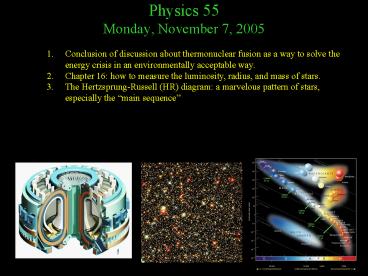Physics 55 Monday, November 7, 2005 - PowerPoint PPT Presentation
1 / 33
Title: Physics 55 Monday, November 7, 2005
1
Physics 55Monday, November 7, 2005
- Conclusion of discussion about thermonuclear
fusion as a way to solve the energy crisis in an
environmentally acceptable way. - Chapter 16 how to measure the luminosity,
radius, and mass of stars. - The Hertzsprung-Russell (HR) diagram a marvelous
pattern of stars, especially the main sequence
2
Please Attend Your Viewing Session
- If you have not completed your two required
viewing sessions, you need to attend your
assigned session if the weather permits. - Only a really good excuse will be accepted before
hand. Illness and travel related to a Duke event
are acceptable, homework is not. - Students who miss their assigned night will get a
zero for their observation grade and lose the
chance to attend any more observation sessions.
3
A Finely Tuned Constant of Nature.007
Fractional Rest Mass Lost inThe Proton-Proton
Chain
4
Zeeman Effect Detecting Magnetic Fields by
Splitting of Spectral Lines.
5
How to Control A Hot Plasma? A Clue From the Sun
Magnetic Fields
6
Tokamak
7
Demo To Explain Why Difficult to Design A
Tokamak Currents Create Magnetic Fields that
Alter Currents.
Currents generate magnetic fields. Changing
magnetic fields change the direction and
strengths of currents in the plasma since the
plasma is free to flow. The new currents lead to
new magnetic fields that alter the currents even
further, a complicated nonlinear effect.
8
Princeton Plasma Physics Laboratory
9
1950s First-Generation Stellarator
10
First Try Did Not Look Like Final Try
11
TFTR Tokamak Fusion Test Reactor
12
Interior of TFTR
13
Generator Rooms Create 4 MA Initial CurrentTo
Start the Heating to Stellar Temperatures
14
How to Get Fuel Into the Magnetic Bottle?
Hydrogen snowball machine gun
15
ITER International Thermonuclear Experimental
Reactor
- Exotic technologies
- Superconducting magnets.
- Liquid lithium blankets to extract heat and
breed tritium. - Core at 30,000,000 K.
- Massive doses of neutrons damage metal support.
- Huge currents needed to start heating process.
- Probes have to be indirect, cant insert objects
into plasma.
To be built in Cadarache, France.
16
Article for Pondering
- Advanced Technology Paths to Global Climate
Stability Energy for a Greenhouse Planet, M. I.
Hoffert et al, Science 298981-987 (2002).
17
Travel to the Stars By Fusion
D-T or D-3He reactions Achieve v 0.1c Decades
to get to nearest stars.
Magnetic ramjet uses interstellar H as fuel (but
p-p reactions hard!!). Constant acceleration at
1g possible with v c since endless fuel supply
12 years body time to 500 ly star, 21 years
body time to center of galaxy, 29 years body
time to the Andromeda galaxy.
18
New Yorker Cartoon
19
Transition to Chapters 16, 17, and 18
- What do the many stars in the skies have in
common? - What key features of a star govern its properties
such as lifetime, color, size, and luminosity? - Roles of different stars in producing nuclei
nucleosynthesis. - Stellar corpses white dwarfs, neutron stars,
black holes.
20
At the WhiteboardLuminosity, Surface
Temperature, Mass
- From radar or parallax angle, know distance d to
star. - From apparent brightness I as measured from CCD
near Earth, can deduce luminosity L of star via - L4pd2I.
- From thermal emission spectrum I(l), but more
accurately from pattern of absorption/emission
spectra, deduce surface temperature T of star in
kelvin K. - From luminosity L, surface temperature T, can
deduce radius R of star via Stefan-Boltzmann - L 4pR2 sT4 or R (L/4psT4)1/2.
- Mass is the hardest property of a star to deduce,
need to have binary star system with special
properties.
21
Measure Apparent Brightness and Distance to Get A
Stars Luminosity
Use charge-coupled diode (CCD), a photon counter,
to estimate apparent brightness over some range
of wavelengths.
22
Distances d To Nearest 500 lyThe Parallax
Formula
23
PRS Dependence of Parallax Angle onRadius of
Base?
If radius R of observation base increases, then
the parallax angle p will 1.
increase. 2. decrease. 3. stay the
same.
24
European Space Agency's Hipparcos satelliteHigh
Precision Parallax Collecting Satellite1989-1993
Hipparcus 170-127(BC) First star catalog Invented
magnitude scale
1,000,000 stars observed. Accuracies of either
.001 or .025
http//wwwhip.obspm.fr/hipparcos/
25
Surface Temperature T fromThe Spectral Type of
Stars
OBAFGKM Oh Be a Fine Girl/Guy and Kiss Me G0
hotter than G1 hotter than G2 G8 gt G9
26
Cecilia Payne-Goposchkin1900-1979
She deduced that all stars are made of H and He,
that the complicated spectral lines could be
understood in terms of various ionized atoms and
a stars temperature.
27
Spectroscopic Binaries
Can deduce period p of motion from period of
shifting spectral lines, but much harder to
estimate semimajor axis a, and so sum of masses
M1M2 of the two stars via Newton. Circular
orbits would work since v2pa/p.
28
Radii and Masses from Eclipsing Binary Stars
Mathematical Insight 16.4 page 531 Newtons
version of Keplers third law plus observation
that ratio of masses M1/M2 same as ratio of
speeds v1/v2, for nearly spherical orbits. Speeds
from Doppler shifts but only useful when star is
eclipsing, else Doppler speed is not total speed.
29
Algol in Perseus
30
The Hertzsprung-Russell (H-R) Diagram
Luminosity Units of Suns Luminosity
Surface temperature T decreasing left to right
31
Mass Is Key to Understand the Main Sequence
Key insights Greater mass implies greater
temperature in core. Greater temperature means
much greater fusion rate. Increased fusion rate
implies higher luminosity. Higher luminosity
implies shorter lifetime.
32
H-R Diagram for Clusters
33
PRS Question
- Assuming your eyes are separated by 6 cm and
that, when you close one eye and then the other,
you see an object jump from side to side by
one-half degree, about how far away is that
object? - 0.7 m
- 7 m
- 70 m
- 700 m

